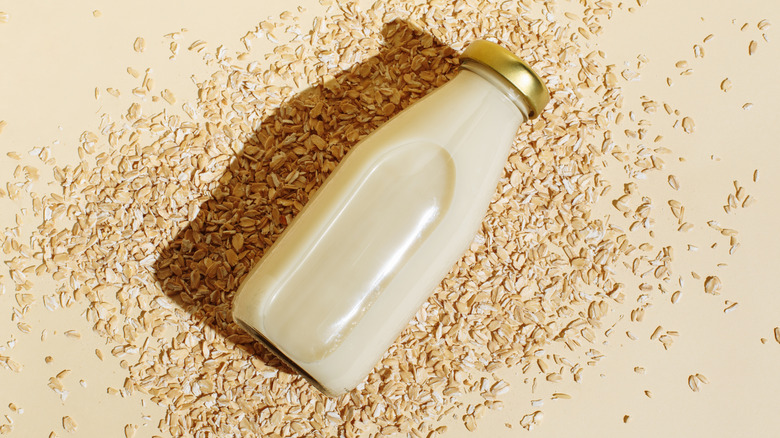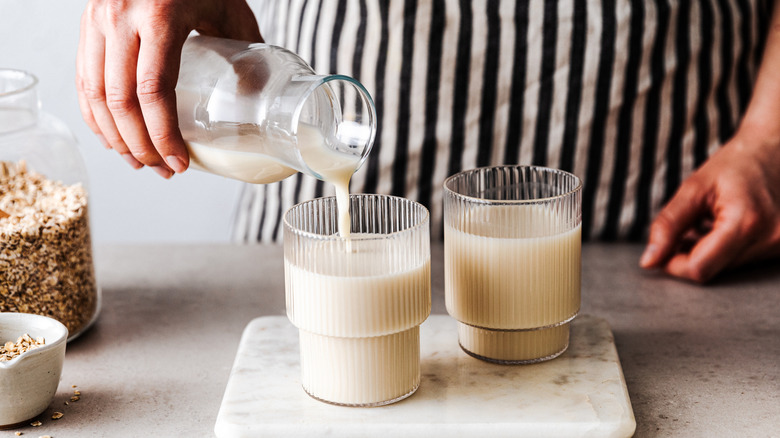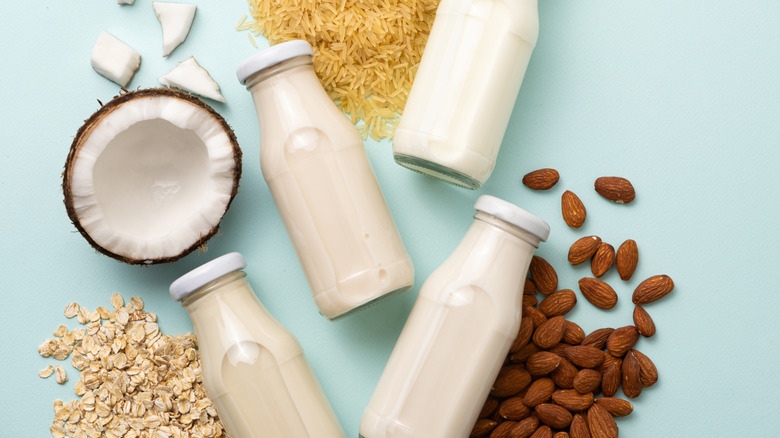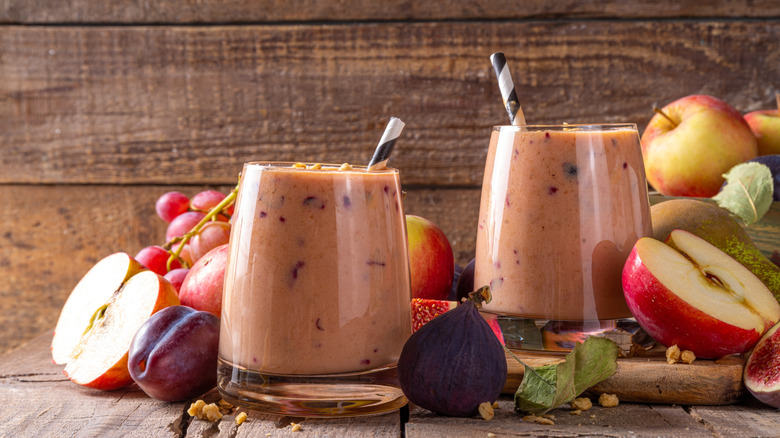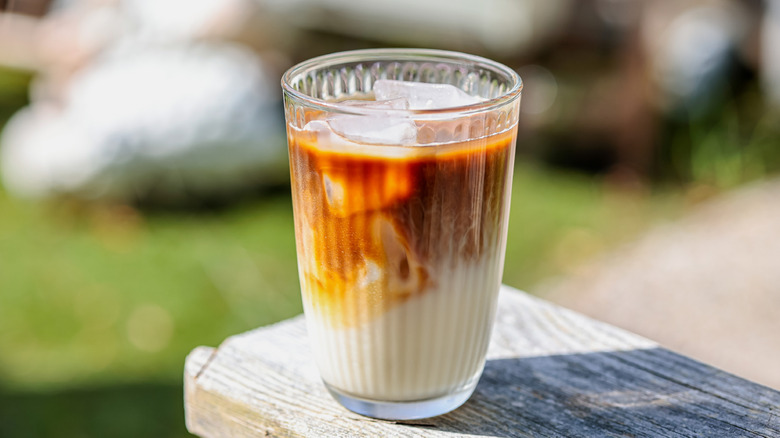8 Disappointing Drawbacks To Oat Milk
Oat milk is everywhere these days. It's in your coffee, your cereal, and even your TikTok feed — anointed as the unofficial drink of the eco-conscious, dairy-free crowd (check out this dairy-free ice cream!). With its creamy texture and claims of sustainability, it's easy to see why oat milk has earned a loyal following. But is it really the perfect solution it's made out to be?
Don't get us wrong — oat milk has its perks. It's a solid alternative for those avoiding dairy, and it's great for frothy lattes and plant-based recipes. But before you go stocking your fridge with cartons of the stuff, it's worth knowing there's a catch or two. From sneaky calorie counts to struggles in the kitchen, oat milk isn't always the hero it claims to be.
That's where we come in. In this piece, we're breaking down the hidden drawbacks of oat milk so you can sip (or pour) smarter. Whether you're a die-hard oat milk fan or just oat-curious, this list will give you the full scoop. Let's dive in and uncover the less-than-creamy truths about this plant-based darling.
Some brands are loaded with calories
Oat milk is a favorite for its creamy texture and versatility, but not all options are as light as they seem. While marketed as a healthy alternative, one of the drawbacks of oat milk is that many brands are surprisingly high in calories and added sugars — especially compared to other plant-based or dairy milks.
For example, OATLY! Original Oat Milk contains 120 calories and 7 grams of sugar per 1-cup serving, while Califia Farms Unsweetened Oat Milk has 100 calories and 2 grams of sugar per serving. On the lower end, Planet Oat Unsweetened Original Oat Milk provides just 45 calories with no added sugar. By comparison, unsweetened almond milk typically ranges from 30 to 40 calories per serving, and 1% cow's milk delivers about 100 calories without added sugar.
So, how can you make smarter choices? Start by reading nutrition labels carefully. Unsweetened versions of oat milk often have fewer calories and no added sugar, making them a better option for health-conscious drinkers. Brands like Califia Farms and others even offer "zero sugar" versions that provide the same creamy texture with fewer calories. Being mindful of serving sizes can also help keep your intake in check. While oat milk is a great alternative for many, understanding how different brands stack up can help you enjoy it without overdoing the calories.
Some oat milk has more than you bargained for
Oat milk is a plant-based powerhouse, but have you ever wondered what makes it so perfectly smooth and shelf-stable? The answer often lies in stabilizers and emulsifiers — ingredients like lecithin, gellan gum, and xanthan gum (which, by the way, will help you make the best cocktails!). These additives keep the milk from separating and maintain that creamy consistency we love. While functional, they're not always a hit with health-conscious consumers.
The problem? Some people prefer their food and drinks to be as natural as possible, avoiding what they see as unnecessary processing. Additives like these, while generally recognized as safe, have raised questions about their long-term effects and potential to cause digestive sensitivities in certain individuals. For clean-eating enthusiasts, the inclusion of these extras can make oat milk feel like a less-than-pure choice.
These stabilizers and emulsifiers can also affect how oat milk performs in cooking and baking. While they help stabilize sauces or prevent curdling in high-heat recipes, they can sometimes leave a slightly gummy texture in baked goods. Choosing brands with fewer additives or unsweetened varieties can lead to better results in the kitchen.
Fortunately, some oat milks prioritize minimal ingredients, using just water, oats, and a pinch of salt while skipping gums and fillers. Organic options with simple ingredient lists also cater to those seeking cleaner products. When shopping, always check labels to find brands that align with your goals for a more natural choice.
It's low protein compared to other options
Oat milk may win points for creaminess, but it's not the strongest contender in the protein department. A typical cup contains around 3 grams of protein, far behind cow's milk at about 8 grams and soy milk at roughly 7 grams. If you're relying on oat milk as a major protein source, you might find it falling short.
Protein is a vital nutrient that helps repair tissues, supports immune function, and produces enzymes and hormones. It's also a key player in keeping you feeling full — important for anyone trying to avoid constant snacking. Research indicates that dairy proteins are particularly effective in promoting satiety, which is why oat milk's lower protein content might leave you reaching for a mid-morning snack sooner than you'd like.
But oat milk isn't out of the game entirely. Fortified versions with added protein, often from pea or soy sources, are becoming more common and can help bridge the gap. Pairing oat milk with protein-rich foods — like nuts, seeds, or even a protein-packed smoothie — can also balance things out.
Natural sugars can mess with blood sugar
Oat milk may be a popular dairy alternative, but it's worth taking a closer look at how it impacts blood sugar. Made from oats, which naturally contain carbohydrates, oat milk can lead to blood sugar spikes — especially if it's sweetened or consumed in large quantities. This is due to the way oats break down during digestion, converting their carbohydrates into glucose.
One way to measure this effect is through the glycemic index (GI), which ranks how quickly foods cause blood sugar to rise. Oats themselves have a moderate GI, but the processing involved in making oat milk can strip away some of the fiber that would normally slow sugar absorption. This means even unsweetened oat milk can lead to a quicker rise in blood sugar compared to whole oats or other low-GI foods.
For people with diabetes or those on low-sugar diets, this can be a concern. Regularly spiking blood sugar can increase the risk of insulin resistance over time. Fortunately, there are ways to enjoy oat milk without compromising your health. Opting for unsweetened varieties and watching portion sizes can help minimize its impact. Pairing oat milk with protein or fat — such as in a smoothie with nut butter or chia seeds — can further slow the absorption of sugars, helping to stabilize blood sugar levels.
Oat milk can be pricer than the alternatives
If you've noticed oat milk costs more than regular milk — or even other plant-based options — you're not imagining it. On average, plant-based milks are priced at $7.87 per gallon, while dairy milk averages around $4.21 per gallon. For oat milk specifically, individual cartons often range from $4 to $6, depending on the brand and region.
Several factors contribute to oat milk's higher cost. The production process involves multiple steps, including soaking, blending, and enzymatic processing to break down the oats into a smooth, creamy liquid. This extra processing adds to production expenses, unlike dairy milk, which benefits from decades of streamlined production and economies of scale.
Demand plays a big role, too. Oat milk's popularity has surged, particularly in coffee culture, where its creamy texture has become a favorite for lattes. With demand outpacing supply in some cases, prices naturally increase. Branding and marketing as premium, eco-conscious products also justify higher price points in the eyes of consumers.
For those looking to cut costs, there are solutions. Store-brand oat milks often come at a lower price while still delivering similar quality. Alternatively, making oat milk at home is a budget-friendly option, requiring only oats, water, and a blender.
It doesn't work well in some recipes
Oat milk's creamy texture is one of its biggest draws, but it doesn't always behave like dairy milk when it comes to cooking or baking. While oat milk excels in certain applications, there are a few scenarios where it falls short, leaving home cooks scratching their heads.
One common issue is separation in soups and sauces. Oat milk lacks the proteins and fats found in dairy milk, which help create stable emulsions. This means it can sometimes curdle or separate when exposed to high heat, resulting in less-than-appetizing results. Similarly, in baking, oat milk's lower protein content can alter the texture of baked goods, leading to less structure or a denser crumb compared to recipes made with dairy milk.
That said, oat milk does shine in certain recipes. It's a favorite in smoothies and coffee drinks, thanks to its naturally sweet flavor and luxe consistency. It's also a great match for no-bake desserts or recipes where it doesn't need to thicken or emulsify. For recipes that demand a closer match to dairy, consider alternatives like soy milk, which offers more protein for better structure, or coconut milk for a higher fat content.
Not all brands foam well for coffee
Oat milk has become a favorite in coffee shops, but not all options are great for foaming at home. The difference lies in the fat content. Traditional dairy milk naturally contains higher levels of fat, which contribute to its ability to create creamy, stable foam. Regular oat milk, however, often lacks the necessary fat and protein balance to produce that same velvety texture.
Barista versions of oat milk are specifically designed to fix this. These blends include added fats — such as canola or sunflower oil — to mimic the creaminess of dairy. The added fats help create a more stable foam, making barista versions ideal for steaming and frothing. Unlike regular oat milk, barista blends are less likely to curdle or separate when heated, giving you a professional-quality latte or cappuccino.
If your regular oat milk isn't cutting it, there are still ways to improve your results. Start with cold milk and use a high-quality frother or steam wand to aerate it properly. Pairing oat milk with other alternatives, like almond or soy milk, can also enhance foam stability. With the right techniques and ingredients, you can achieve café-worthy results in your own kitchen.
The taste of oat milk isn't for everyone
A creamy texture and naturally sweet flavor have earned it a loyal following, but let's face it — one of oat milk's drawbacks is that it's not everyone's cup of tea. Unlike the neutral taste of dairy milk, oat milk carries a distinct flavor that's earthy and slightly nutty. While some find this appealing, others feel it can overpower the subtle flavors in certain recipes or drinks.
One common complaint is that oat milk's sweetness doesn't pair well with savory dishes. For instance, using oat milk in soups or sauces can introduce an unexpected base of sugar that may throw off more savory or salty flavors. Similarly, when added to coffee, its natural oat flavor might not blend seamlessly with certain roast profiles, especially darker, more bitter coffees.
For those who aren't fans of oat milk's taste, there are ways to work around it. Pairing it with complementary flavors, like cinnamon or vanilla, can help smooth out its unique profile. In recipes where the oat flavor might clash, alternatives like almond milk or soy milk can offer a more neutral option. Unsweetened versions of oat milk also tend to have a milder taste, making them less likely to dominate a dish. While oat milk isn't everyone's first choice, understanding its flavor profile and where it works best can help you make the most of this popular dairy alternative — or explore other options that better suit your palate.
